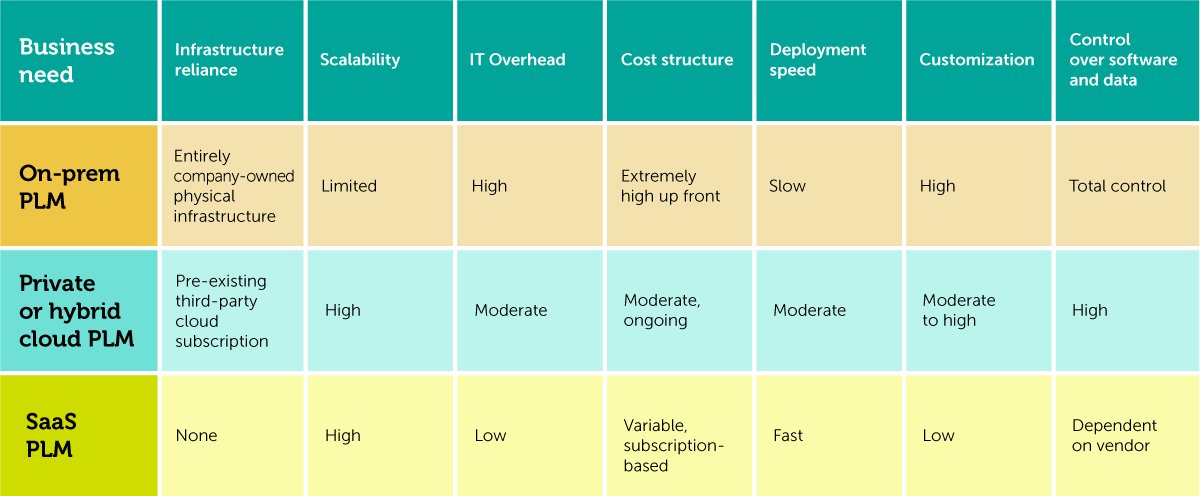.png?width=570&height=650&name=Trace%20One%20Devex%20PLM%20PDM%20(2).png)
The Future of Product Lifecycle Management
With the shift away from traditional on-premises (on-prem) PLM implementations, your company may be facing new questions about how to manage these solutions. Should you move to a cloud-based PLM system? Is there a difference between cloud PLM and SaaS PLM? Which model truly fits your business?

Industry Tailored Solutions
Your organization might operate in a technically complex, highly regulated manufacturing industry like food and beverage, cosmetics, or chemicals. Or it could be a private label retailer responsible for shaping a brand to meet consumer needs. Regardless of your industry, there’s a PLM delivery model that matches your budget, IT capacity, product complexity, and regulatory environment.
The first step is knowing what cloud-based PLM software can accomplish and what it can do for your business. Once you have your solution in place, you’ll have the power to innovate faster, deliver higher-quality products, and ensure compliance while driving more sustainable progress.

.png?width=570&height=650&name=photo1%20(1).png)
Cloud PLM vs. SaaS PLM Solutions
People often use the terms cloud and SaaS interchangeably, but that isn’t the whole picture. They represent distinct approaches to deployment and access, and understanding their differences is the key to making the right investment.
For decades, companies hosted their PLM software on-prem: implementing, maintaining, and upgrading their servers in-house. As time went on, advances in delivery methods emerged alongside pressures to modernize, reduce IT overhead, and improve collaboration. As a result, many companies have moved to cloud-based PLM software.
But there are different approaches to the cloud. It’s important to understand what the terms cloud PLM and SaaS PLM mean to help guide your strategic decision-making.
Key Differences
In the simplest terms, you can understand cloud PLM and SaaS PLM like this:
- Cloud PLM refers to PLM software hosted on public, private, or hybrid cloud infrastructure, where a company will still rely on its internal team for IT management.
- SaaS PLM refers to a specific model of cloud-based delivery, where a third-party provider delivers a subscription-based PLM solution maintained by its own IT professionals on a public cloud.
.png?width=1000&height=563&name=Cloud%20vs%20SaaS%20Pillar%20Page%20(2).png)
The Future of Product Innovation
Both of these approaches rely on the cloud, but the level of control, customization, and data ownership differ significantly. Meanwhile, on-prem approaches are still common and valuable for many companies. Some organizations operating in highly regulated industries might elect for on-prem setups because of data residency, compliance, or integration requirements that demand strict internal IT policies. Often, those requirements arise from highly sensitive or hazardous product formulas.
Ultimately, choosing the best PLM deployment for your organization depends on understanding what each model offers.
What is Cloud PLM?
Cloud PLM software refers to solutions hosted on cloud infrastructure and accessed through the internet, private networks, or enterprise-managed environments. You can implement a cloud PLM solution in different configurations depending on your needs.
There are four common approaches to cloud PLM:
The PLM system runs on shared infrastructure managed by a third party, typically offering subscription and pay‑as‑you‑go pricing models for virtually unlimited scalability, rapid deployment, and minimal IT overhead.
The company hosts its cloud PLM software on infrastructure dedicated solely to one organization, offering high levels of control, security, and customization, as well as private network access that accommodates heightened security, data residency, and compliance requirements.
This approach combines private cloud with public cloud resources, offering flexibility and scalability while maintaining critical systems in a private environment.
Several organizations with similar requirements share infrastructure. This approach is comparable to a private cloud but extends to more than one company.
Different cloud models deliver different capabilities, but all of them offer distinct advantages and limitations when compared with an on-prem implementation.
Advantages of Cloud PLM |
Limitations of Cloud PLM |
|
Scalability: Without the responsibility to build and maintain their own servers, companies can easily scale infrastructure and features as the business grows. |
Cost over time: While initial investment is lower than on-prem implementations, long-term costs might accumulate based on infrastructure and services. |
|
Centralized data: All stakeholders access the same source of truth connected to relevant modules and supporting tools, which minimizes duplication and errors. |
Data migration and integration complexity: Transitioning legacy systems and structures into a cloud PLM can be resource‑intensive, and it carries some risk. |
|
Improved collaboration: Because teams access cloud-based PLM software through the internet, they can collaborate in real time, regardless of location. |
Security and privacy concerns: Storing proprietary product data in the cloud is an overwhelmingly secure option, but some companies have concerns related to data sovereignty, unauthorized access, and compliance with regulations across jurisdictions. |
|
Reduced IT burden: Compared with on-prem implementations, cloud PLM solutions require less hardware and infrastructure to manage internally, so IT departments can conserve resources. |
Vendor management: Organizations need strong cloud vendor governance to ensure uptime, data privacy, and performance. |
For manufacturing industries like food and beverage, cosmetics, and chemicals, cloud PLM software offers a modern, flexible solution that supports strong compliance, traceability, and rapid product innovation.
.png?width=1200&height=675&name=Cloud%20vs%20SaaS%20Pillar%20Page%20(1).png)
What is SaaS PLM?
Software as a Service (SaaS) is a specific approach to public cloud-based PLM software delivered on a subscription basis. The vendor who provides the PLM solution manages the implementation from the ground up, including maintenance, updates, security, and infrastructure.
This model appeals to businesses looking for a quick deployment with minimal internal IT involvement. Because SaaS solutions are vendor-managed, they’re fast, scalable, and simple to operate. They work especially well for the retail space.
There are trade-offs to consider, though. If your organization has exceptionally strict compliance, customization, and confidentiality needs, a self-managed cloud might be right for you. But it’s important to note that legitimate SaaS PLM solution providers ensure data doesn’t leak between tenants on the public cloud. Greater data segregation is only necessary in extremely sensitive cases.
Advantages of SaaS PLM |
Limitations of SaaS PLM |
|
Lower upfront cost: SaaS PLM tools remove large initial license or hardware investments, replacing them with predictable subscription pricing. |
Limited offline access: SaaS platforms typically require continuous internet connectivity, so they rarely support offline work scenarios. Remote manufacturing sites, secure labs, or low-connectivity regions may struggle with these limitations. |
|
Rapid implementation: Because the provider pre-installs and manages its own tools, companies can deploy SaaS PLM software quickly, with minimal setup time. |
Integration challenges: Some SaaS PLM platforms can be difficult to integrate with legacy systems or internal tools due to compatibility gaps, proprietary APIs, or limited support for complex enterprise workflows. |
|
Vendor-led IT management: The vendor handles all technical aspects of the SaaS solution, including maintenance, patching, and automatic updates, so the burden on an organization’s IT team is almost non-existent. |
Vendor dependence and lock‑in: Organizations can become dependent on the provider’s roadmap, facing challenges if they need to migrate to another solution. |
|
Simplified pricing models: Conventional SaaS pricing models like flat-rate or per-user subscriptions offer clarity and predictability, helping businesses budget more effectively. |
Data control concerns: Companies have limited control over data storage locations and access protocols, leading to fears about IP protection and compliance. |
|
Specialized compliance: Providers of industry-specific SaaS PLM tools have the expertise and resourcing to ensure they enable compliance with relevant certifications and regulations. |
Possible performance limitations: SaaS applications may run at slower speeds than on-prem alternatives in some cases where organizations share infrastructure or experience high network latency. |
.png?width=570&height=650&name=Cloud%20VS%20SaaS%20Pillar%20Page%20(4).png)
How SaaS PLM Accelerates Time to Market
For private label retailers and manufacturers that manage large SKU assortments, fast trend cycles, and geographically distributed teams, SaaS PLM software offers rapid deployment, minimal upfront cost, and effortless scalability. As a result, it enables real-time collaboration and supply chain visibility, reducing errors and accelerating time to market. For manufacturers, a SaaS approach is especially useful in leaner settings or rapidly scaling circumstances.
.png?width=570&height=650&name=Trace%20One%20Devex%20PLM%20ERP%20(1).png)
Finding the Best Fit Which PLM Investment Is Right for You: On-Prem vs. Self-managed Cloud vs. SaaS?
Choosing between on-prem, cloud, and SaaS PLM software depends on your needs and priorities. Each model offers distinct advantages and potential limitations that will matter for different organizations.
Consider a wide array of factors that include the state of your existing infrastructure, your level of IT resourcing, and your privacy and sensitivity environment. Whatever your needs, the following breakdown can help guide your decision-making.

.png?width=1000&height=563&name=Cloud%20vs%20SaaS%20Pillar%20Page%20(5).png)
CATEGORY-DEFINING INNOVATION Why Trace One?
There’s no one-size-fits-all approach to PLM tools. That’s why Trace One supports a variety of cloud PLM software delivery models to match your organization’s industry, product complexity, regulatory environment, and more.
You decide whether SaaS, a self-managed cloud, or even on-prem delivery works best for you. From there, Trace One can help you enhance business operations to boost product development and ensure regulatory compliance. Whatever implementation you choose, Trace One solutions reduce risk, simplify processes, and drive cost savings from ideation to market launch, giving you the power to deliver remarkable products.
- Eliminating the PLM vs ERP Divide
- Mass Data Transfer
- Continual Data Maintenance
- Get to Know the Trace One Process
- SAP PLM Integration
- Store and synchronize data: Store product iterations on your PLM platform and synchronize the data for finished products.
- Unify material master management: Create material masters in your PLM and ERP systems simultaneously to keep materials, classifications, documents, and BOMs in one place.
- Ensure consistency across systems with centralized data that’s continuously up to date.
- Eliminate lag time: Kick off manufacturing as soon as you create material masters and automatically translate recipes for your ERP system.
- Connect and streamline: Trace One Devex PLM Open Connecter simplifies data transfer through a built-in mass import/export tool, eliminating the need for manual re-entry.
- Automate: Automatically format unstructured data to make it compatible with your target system.
- Standardize and simplify: Integrate data from multiple systems with one standardized tool based on native SQL technology.
- A scalable solution: Trace One Devex PLM Enterprise SOA Connecter offers more complex product information management for businesses that need real-time data updates for multiple processes.
- Assured accuracy: Properly format critical product data between systems, ensuring calculations for trace substances, weights, costs, and other key properties.
- Flexibility where you need it: Flexible business logic works with your company’s specific processes and data formats.
- Blueprinting: We guide your teams through fast, effective design workshops to discover the perfect configuration for your new PLM system.
- Implementation: Trace One builds the PLM system based on your unique requirements. We’ll help you settle into your new workflows and support each team on their part in data migration.
- Validation: Before launch, we validate the PLM system in your environment based on established use cases and perform detailed testing.
- Go live: The clear and guided Trace One approach works to mitigate risk, nerves, and resistance to change. Our experts create a project plan with an eye to minimal downtime as the shift is made from in-development to a live environment.
- SAP-friendly: Trace One Devex PLM SAP Connector links directly to your SAP database to translate PLM data and connect complex workflows.
- Direct data relationships: Build a direct relationship between PLM materials and SAP material masters, specifications, vendor and customer information, and support documentation.
- Visibility and traceability: Enable robust error handling and event logging.
Our Customers Include
Let’s Get in Touch
Connect with our certified PLM professionals to get started.




























